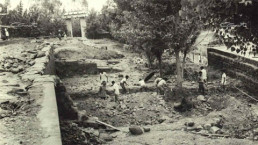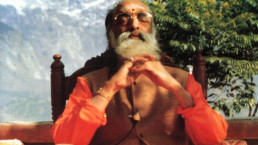Pujya Gurudev had two clear aims for the ashram in Sidhbari. First, the essence of the scriptures must be spread among the Hindi-speaking people of the Himalayan region and North India. The second was to uplift the lives of the Pahadis, the natives of the Himalayan region, who had faithfully served the saints and sages in the mountains.
Parama Guru Swami Tapovan Maharaj had passed through the Kangra valley during his trek across the Kangra region. Walking in the footsteps of His beloved Guru many years later, Pujya Gurudev Swami Chinmayananda came to Sidhbari after finishing a yajna at Shimla in 1977. Instinctively tuning into its spiritual heritage, Pujya Gurudev could envision that Sidhbari would be home to Chinmaya Tapovan, a crest-jewel of Chinmaya Mission. Blessed by the ancient rishis and fit to be an apt spiritual legacy of Swami Tapovan Maharaj, the ashram at Sidhbari would be an offering of Chinmaya to Tapovan. There, the bliss of Knowledge (Chinmaya) would revel in a forest of penance (Tapovanam).
The time had also come for a greater debt to be repaid to the Pahadis who had served the sages and saints in the Himalayas for countless ages. Pujya Gurudev’s mission aimed to empower the people in the Himalayan valleys with the strengthening devotion of Tulsi Ramayana as well as the means to achieve healthier and economically better lives.
Pujya Gurudev knew that the work ahead may not be fully understood. In His words:
I am now turning my full attention to an aspect of the revival program which we had to seemingly neglect so far, as we had neither the leisure nor the required workers to serve the poor but noble people living in the interior villages of the Himalayas – the Pahadies; nor had we the workers for the Hindi areas.
I had been planning this for the last three years, scouting for the right place, discovering the required funds and building the campus for running the Sandeepany (HIM). In the Himachal Pradesh, in the rich Kangra Valley, just down below the famous Dharmsala, adjacent to the Yol Cantonment, we are now erecting a campus to accommodate 40 Brahmacharis to preach in the predominantly Hindi-speaking areas, and some 20 Brahmacharis to serve in the upper and interior areas of the Himalayas – from Kashmir to Almorah.
This is a gigantic work, amidst a people who cannot now see through our vision-oriented program, and so are at present, not so very enthusiastic about us and our work. That will not discourage us; and, we are sure we will soon catch their attention and compel their respectful admiration by the sheer benevolence of our services to their community.
The purpose was strong – to train a new generation who will carry the wisdom of Hindu Sanatana Dharma around the world. The promise was firm – the lives of the people of Himachal would be uplifted – materially and spiritually – through the grateful love nurtured by a global Master, a son of Sidhbari, Pujya Gurudev.
Chinmaya Tapovan Sidhbari would become the ashram of many blessings to the entire Himachal region and the world in the years to come.
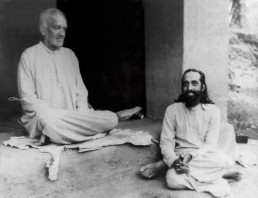

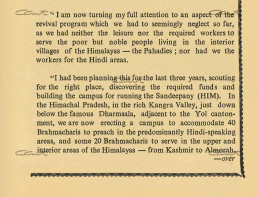
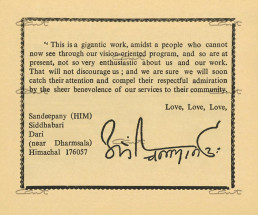
Navigation
Next Topic
The Preparation
Noble as the beginning was, it required labor, penance, and patience. But with Pujya Gurudev's astute guidance at every step the barren hillock in the Kangra…
Home Page
Sidhbari Ashram
Chinmaya Tapovan ashram in Sidhbari shines as the crest-jewel of Chinmaya Mission where the Grace of the Guru awakens the thirst for Knowledge ripened with devotion.
Previous Topic
The Place
Nestled in the Dhauladhar mountains, Sidhbari in Himachal Pradesh, India, holds a special place in the heads and hearts of the devotees at Chinmaya Mission…
